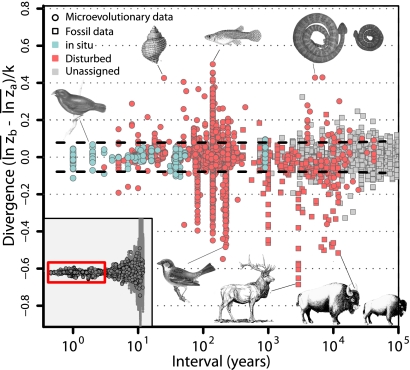Fig. 5.
Divergence identifiable as natural in situ variation vs. disturbance-mediated community change demonstrates that the majority of cases of rapid evolution over microevolutionary timescales are from identifiable causes such as introductions, anthropogenic disturbances, and island isolation. Highlighted examples include (clockwise, starting from left) in situ evolution of Geospiza fortis in response to natural climate variation, divergence in Nucella lapillus in response to an introduced predator, introduction of Gambusia affinis to Nevada and Hawaii, island–mainland divergence in Crotalus mitchelli, Holocene dwarfing of Bison antiquus to B. bison, dwarfing of Cervus elaphus on Jersey Island, and the introduction of Passer domesticus to North America and New Zealand. Most fossil time series cannot be assigned to either group, but are expected to record primarily in situ evolution of wide-ranging species. Dotted lines indicate the 95% confidence interval for simulated measurement error given equal means, average within-population variance, and a distribution of sample sizes matching those found in the data (SI Text).

